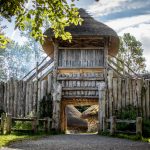Selskar Abbey Wexford Town
Selskar Abbey is a 12th-century structure that replaced a pre-Christian temple dedicated to Odin. The complex, which is part of the Westgate Heritage Tower, was the location where the first Anglo-Irish treaty was signed. In 1172, Henry II also spent Lent at the abbey, as he did penance for having Thomas Becket beheaded.
After years of suppression, the abbey was destroyed by Oliver Cromwell in 1649. The present Protestant church was built in 1818.
In the past, local historians have floated the idea that the name Selskar is a corruption of the name St Sepulchre (the Holy Sepulchre is a term that is often used when referring to the tomb of Jesus Christ). An alternative theory is that the name derives from an old Norse phrase that means “seal rock” (seal skar). This theory is also plausible, as the River Slaney would have been relatively close to the area at the time (it is believed that there was an outcrop in the river in this area).
In 1169, the first Anglo-Irish treaty was signed on the grounds of the abbey. Diarmait Mac Murchada, who had been exiled from the country by the High King of Ireland, returned to the shores of County Wexford with a sizeable force of Norman soldiers, which had been given to him by King Henry II of England. This force immediately laid siege to Wexford Town. Although they were met with a fierce resistance from the Norse inhabitants of the town, the siege was eventually lifted when the Bishop of Ferns managed to persuade the townspeople to surrender.
In 1172, it is said that King Henry II of England stayed at Selskar Abbey. According to legend, he stayed at the abbey during lent so that he could do penance for the murder of Thomas Beckett. Beckett, who was the Archbishop of Canterbury at the time, was murdered in 1170 after Henry II’s men “misinterpreted” some of his words. At the time, the archbishop was notorious for excommunicating anyone that opposed him. When news filtered through that Beckett had excommunicated three bishops, King Henry II reacted by saying “Will no one rid me of this turbulent priest?” Although the story of King Henry II’s visit has not been proven, it has been deemed as plausible, simply because he was known to be in Ireland at the time.





